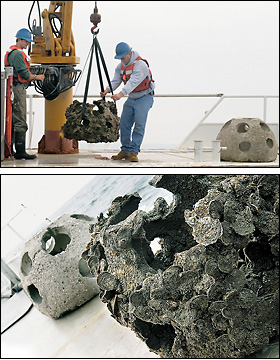 |
| Photo by Alison
Harbaugh — The Capital |
 |
TOP: Capt. Karl Willey,
left, and volunteer Dan Johannes guide a reef ball from
the Eastern Bay onto the deck of the Chesapeake Bay
Foundation’s Patricia Campbell. At right is a new reef
ball, taken along for comparison. BOTTOM: A close look
at the two
balls. | | 'Reef balls' providing homes for marine
life
Officials pleased with results of effort thus farBy PAMELA WOOD, Staff
Writer
Few people ever get to see what goes on below the surface of
the bay, where oysters grow, crabs scuttle and fish dart around.
On a gray, foggy morning last week, a crew from the Chesapeake
Bay Foundation hoisted an innovative part of the bay's underwater
life to the surface to show it off - a holey, concrete "reef ball"
covered in oysters.
Dark and a bit
scary-looking from far away, the reef ball hauled up from the bottom
of Eastern Bay is actually prime habitat for all sorts of underwater
critters.
Environmental officials were
pleased with the looks of the reef ball, one of dozens that were
planted at the bottom of the bay last fall.
Though they made sure the reef balls were
looking good before inviting a boatload of journalists to the site,
officials weren't so sure what they'd find when they first monitored
the site earlier this year.
"The really
exciting thing is we didn't entirely know what we were going to
find," said Stephanie Reynolds, a fisheries scientist for the
foundation.
When scientists checked the
balls earlier this year - by sending divers down and hauling reef
balls up - they were pleased to find them covered with healthy
oysters, mussels and other critters.
"We
saw virtually no dead oysters on any of these," Ms. Reynolds
said.
Reef balls have been a popular
restoration project in the Chesapeake Bay. The bay bottom is covered
with hundreds of them. Fishermen like them because they attract
oysters, and in turn, fish.
While there
have been plenty of projects to create and deploy reef balls, the
monitoring of the sites is just now starting to catch up.
For Thursday's demonstration, the CBF's
Patricia Campbell, with its large yellow crane, anchored at the
Hollicutt's Noose site in Eastern Bay. A high-tech National Oceanic
and Atmospheric Administration boat, Bay Commitment, motored
nearby.
NOAA employee Rich Takacs dove
down 15 feet to find one of the reef balls. He attached a yellow
inflatable "lift bag" to float the reef ball closer to the
surface.
Patricia Campbell Capt.
Karl Willey and volunteer Dan Johannes used the ship's crane to
bring the reef ball up onto the deck. There it sat next to a new
reef ball that hadn't been deployed, for comparison.
Mr. Takacs said it isn't exactly easy
monitoring the reef balls. But it's vital to see how well they're
working.
"Part of the challenge is the
monitoring is almost as complex as the restoration," he said.
Some of the reef balls in Eastern Bay got
something of a head start when it comes to the oysters.
After volunteers poured concrete to create 69
reef balls, 27 of them were placed in giant tanks filled with bay
water at the CBF's oyster center at Discovery Village in Shady Side.
Then scores of tiny, free-swimming oyster larvae were dumped in the
tanks.
"They matured to the point they
needed to stick to something," Ms. Reynolds said.
In this case, "something" was the reef
balls.
With the baby oysters attached,
the reef balls were then placed on the bottom of Eastern Bay.
Last week's demonstration of the year-old reef
balls shows that the science is working, officials said.
Ms. Reynolds said most of the oysters were 2
or 3 inches - well outpacing the normal oyster growth rate of 1 inch
per year.
The bay foundation and NOAA
will continue to monitor the Eastern Bay reef balls, as well as
others in the Chesapeake Bay.
Next
Top Story
Top Stories
Page
Published October 23, 2006, The Capital, Annapolis,
Md.
Copyright © 2006 The Capital, Annapolis,
Md. |







